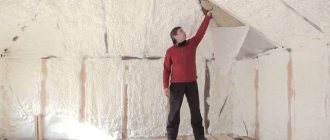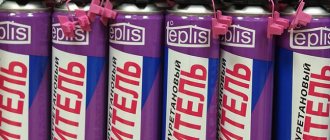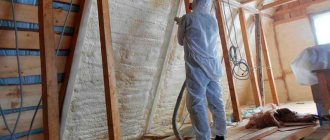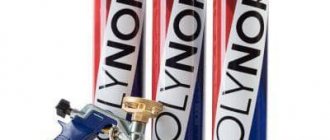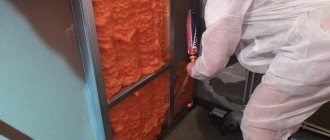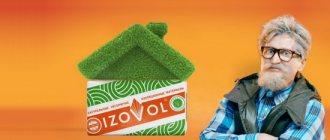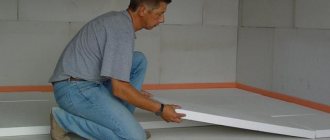The technology of insulating buildings in modern reality is in a mode of permanent improvement and now there is already a set of extremely effective production measures (along with building materials), which differ significantly from those that were used relatively recently, 10-20 years ago. Today there are various types of sprayed thermal insulation that can efficiently insulate large surfaces. The development trends of such materials indicate that they may soon become the only high-quality and easy-to-use thermal insulators.
Structure and specificity of the sprayed substance
A sprayed thermal insulator is actually an analogue of polyurethane foam, which is applied to the surface by spraying from special equipment (special cylinders). Such a substance consists of two liquid substances, the mixing of which forms a large amount of foam material, with the help of which certain areas are covered.
The main component of the above substance is polyurethane foam. It is, in fact, a special mixture, the components of which are isocyanate and polyol, i.e. synthetic polymers:
- The first component is a hydroxyl-containing substance necessary to carry out the reaction with the second component. The solution has a dark brown or yellowish color; its structure may contain various catalysts and polyesters, foam regulators, flame retardants or foaming elements.
- The second component is isocyanate, has a dark brown color, remains liquid, and has a characteristic odor. When this component reacts with the open atmosphere, the resulting polyurethane begins to harden and become unusable. This shows that the second component must be supplied/stored in sealed containers so that the entire composition is reliably protected from contact with air or moisture (i.e. deliveries are made only in special cylinders).
When mixing the first and second components, their active interaction occurs, which is accompanied by the release of carbon dioxide, which is responsible for the foaming of building insulation. As it hardens, polyurethane creates an insulating layer. Such a layer will consist of a huge number of isolated cells, completely filled with acid. Thus, thanks to this technology, a qualitatively low heat transfer coefficient is formed, which is optimal for insulating surfaces.
Technical properties
The sprayed thermal insulation material is extremely light in weight and can be applied to various surfaces without any difficulties, despite the fact that the applied layer can be of any thickness. Its unique properties are very practical for a certain type of construction and finishing work, which is well known to both novice craftsmen and professionals:
- It is these insulation materials that have the highest thermal conductivity, which can range from 0.020 to 0.028 W/mS. In modern samples of sprayed heat insulators, this indicator is even lower, which makes their use preferable for high-quality insulation.
- Their sound insulation is also at a high level. Such insulation effectively reduces even extremely strong mechanical noise that can interfere with normal sleep and rest of a person, and creates the most ideal conditions for life. From this we can conclude that achieving a minimum noise level can be achieved even when using special instruments with high noise output.
- Sprayed thermal insulation materials have such vapor permeability that they simply absorb moisture, and the amount of condensation simply cannot form in large volumes that could cause harm to the coating.
- The use of this innovative substance allows you to insulate very hard-to-reach places due to its unique consistency.
- Indicators of adhesion to materials (adhesion) are also high - such insulation can be used on almost any surface.
- The speed of insulation work performed with sprayed substances can be defined as record-breaking. To process from 100 to 200 square meters it will take 9-10 hours, and the process itself will not be so labor-intensive;
- Separately, it is worth noting the resistance to interaction with various types of chemically aggressive reagents and biological microorganisms.
- The created coating has an extremely extended service life, and will also be able to successfully withstand precipitation of the same type (for the area of its application) and the aggressive atmosphere of various industrial productions. At the same time, it may not suffer from the activity of biological pests and organisms;
- It should be noted that the polyurethane base with a density of 70 kilograms per cubic meter is absolutely impermeable to moisture, which allows this material to be used as a worthy replacement for waterproofing.
IMPORTANT! Although most experts are not inclined to classify sprayed waterproofing as a non-flammable substance, its first components may include fire retardants, which will make it difficult for fire to spread. Therefore, many types of thermal insulators under consideration have a non-flammability class of G2. In addition to the fact that the substance itself does not support combustion well, the fire retardants included in the structure will contribute to rapid self-extinguishing, which will be ensured through the rapid release of carbon dioxide from the structural cells. The usual material consumption is 890 milliliters per square meter with a layer of five millimeters.
Advantages and disadvantages
The heat insulators under consideration will serve as an ideal barrier to heat loss in the cold season and will help reduce the cost of air conditioning a room in the warm season. At the same time, to create high-quality insulation, you don’t even need to apply an extremely thick layer of the substance - just a few millimeters of a layer of foam will be enough for arranging interior spaces. In addition to the above, the following positive characteristics can be noted:
- The material is applied in a fairly convenient way, by spraying it from a special construction sprayer connected to a compressor. Thus, during the application process and after hardening, an absolutely seamless layer will be created, eliminating the formation of “cold bridges” at the joints and in places where the foam adheres to the load-bearing elements of the surface.
- Due to the fact that polymerized foam does not absorb moisture at all, it is able to withstand a sufficient number of consecutive freezing/thawing cycles, while ensuring proper integrity to the internal structure. As mentioned above, this thermal insulator is able to withstand the effects of many unfavorable factors - from weather to interactions with harmful microorganisms. If the necessary installation conditions are met, the warm layer can last approximately 50 years without losing its useful characteristics.
- The spray-applied layer adheres well to most building materials used, even such as metal or plasterboard. However, before spraying, smooth substrates must be properly prepared by cleaning them from dirt, debris, and greasy stains.
- During the installation process, it is generally not necessary to use lathing, adhesives or any brackets - this circumstance significantly saves the future construction budget. If a decision is made to use lathing, then it may be needed, perhaps, for fastening an external decorative covering, which may include siding, drywall or ordinary lining. From this it can be seen that even a beginner in finishing work can complete the installation without any problems.
- As a result of hardening, the foam gains such strength that it can easily withstand even significant impacts. Accordingly, the substance in question can also be used as a heat insulator for basement floors and foundations of buildings that have a certain depth of depth. And during backfilling and intensive use, the sprayed insulation does not deform, which is also considered an important positive characteristic.
However, like any building and finishing material, sprayed insulation is not perfect and has a number of disadvantages:
- The total cost of 1 square meter insulated by spraying will be significantly more expensive than when using old insulation options - mineral wool or polystyrene foam. Nevertheless, the extremely high quality indicators of using the latest material will allow you to quickly recoup the costs invested in finishing.
- The application process will require special construction and finishing equipment, for which, as a rule, a compressor is used in conjunction with a special device, with the help of which the two components will be mixed. This equipment will have to be purchased separately, however, if the proposed work is not so large-scale, then it can be rented.
- The operator only needs to wear special protective equipment. Despite the fact that after polymerization the substance becomes absolutely harmless to humans, the spraying/foaming process itself is associated with the release of harmful chemicals, so such work should be carried out by a specialist only in a respirator. And to protect the skin from the adhesion of excess foam (which is very difficult to remove later), you should use overalls or other protective clothing.
- The main disadvantage of foam coating is its poor resistance to ultraviolet rays. When exposed to direct sunlight for a long period, the structure of the substance is subject to rapid decay. Thus, the outer layer of insulation should always be protected with decorative material (panels, siding, cement plaster).
What is polyurethane foam insulation?
The product belongs to the category of modern thermal insulation materials. The composition contains two components - isocyanate and polyol. Apply to the surface using a sprayer. In a short time, the composition foams, and the volume increases by more than a hundred times. Distinctive features of the product:
- unique fixation on any surface;
- quick drying;
- excellent thermal insulation properties;
- wide temperature range.
Scope of application of the material
The scope of use of polyurethane thermal insulation is quite wide. We are talking about a wide variety of coatings, including floors. The average price of products is high, however, the characteristics are excellent.
Based on the structure, the material is divided into the following types:
- elastic;
- hard;
- integral.
Let's consider the main areas of product use:
| Options | Description |
| Technological containers | We are talking about storage heaters. Shows efficiency, strength and durability. |
| Roofs | An ideal option for roof insulation. Not afraid of direct sunlight, does not decompose. Shelf life – 50 years. |
| Floors | The composition fits perfectly on any horizontal surface. The layer thickness is minimal. The distance between the ceiling and the floor is practically not reduced. The curing time of one layer is several seconds. |
| Walls | Both external and internal walls are processed. They prevent the negative effects of wind, precipitation, significant temperature changes, and so on. The consumption is small. |
| Attics | The best option for attic spaces that have an intricate appearance. You can foam the most inaccessible places and joints. |
Material advantages
Regardless of whether the product is from a foreign or domestic manufacturer, it has undeniable advantages compared to its analogues. Let's pay attention to the main advantages:
- Complete curing time is minimal.
- Ecological cleanliness.
- Completely harmless to others.
- The level of water absorption is high.
- Has anti-corrosion properties.
- Absence of harmful components.
- Resistance to mechanical damage.
- Withstands significant loads and impacts.
- Length of service life.
- Preservation of original characteristics during numerous thawings and freezing.
- Saves space heating costs.
- Perfect adhesion.
- Seamless technology.
- Complete elimination of the formation of cold bridges.
- Acceptable price.
What are the popular product models? They are available in two types:
- industrial;
- in cans.
The first option is sold in barrels. Purchased when it is necessary to insulate large areas. The consistency is liquid. Cans up to 1 liter capacity. Purchased for household use. Convenient for use in small spaces.
Everyone's selection criteria are different. Which product is best to buy depends on many factors. If it’s difficult to decide on a purchase, you need to listen to the recommendations of professionals. If the coverage area is significant, it is better to pay attention to the following products:
- Selection Products from an American manufacturer. Open structure. Fire resistance class – 2G.
- Ecotermix. The main component of the composition is vegetable oil. There is also a foaming agent and water. Harmful components are in minimal quantities, so they do not have a negative effect on the human body. Available in two types: 600 and 300. The first is applied to internal coatings, the second - to external ones.
- Healtok Soy Raw materials with a closed state. The composition contains polymer residues and soybean oils. After application, the volume increases 50 times. The attachment to the surface is excellent. Ideally fills voids and cracks.
Terms of use
There is nothing difficult in working with sprayed insulation. You need to have a special compressor and a gun available. The kit costs little money. Working with two-component polyurethane compounds requires experience and skill. They are not available for free sale. Ordered from specialized production. The sequence of actions is as follows:
- The component is mixed using a mixer.
- The second component (hardener) is shaken.
- The ingredients are mixed in a ratio of 1 to 1. The humidity in the room should be minimal. Dust and debris should not get into the mixture.
- The resulting composition is filled into the tank.
- Apply using a gun.
The stages of applying polyurethane are as follows:
- The surface is tidied up (loose plaster or paint is removed).
- The sheathing is constructed from wooden beams or metal profiles.
- The gun is being adjusted.
- The insulation is applied to the surface in a thin layer.
Experts advise strictly following these rules:
- Do not start work in extreme heat or severe cold.
- In the presence of rain and high humidity, the insulation process should be abandoned.
Before you start using insulation, you need to carry out preliminary preparation of the surface: clean it of dirt and dust, remove greasy stains, and dry it thoroughly. There's no need to rush. Sometimes preparatory work has to be repeated several times. There is no need to apply the product in a thick layer. Sufficient thickness is from 2.5 to 8 cm. If necessary, you can apply a second layer of insulation, waiting until the first ball is completely dry.
Scope of use
The material in question for insulation, if its composition complies with all safety standards, can be used for finishing both residential and public buildings. With its help it is possible:
- Insulate attic/roof structures of various shapes and types;
- Carry out thermal insulation of floor coverings in public institutions and residential premises;
- Perform insulation of wall ceilings in different buildings.
- Depending on the purpose of the structure, it is possible to propose the following categorization:
- Industrial buildings;
- Outbuildings for various purposes;
- Refrigeration rooms;
- Pipelines;
- Technological tanks and reservoirs for various purposes.
Features of self-application
Most owners of detached housing (and even some large apartments) prefer to apply the composition on their own. However, under certain conditions this process can cause some difficulties. First of all, you need to take care of the availability of special equipment and technical components, namely you will need:
- Isocyanate mixed with freon 134;
- Polyol mixed in a cylinder with freon.
These cylinders must be filled so that their internal pressure is at least eight atmospheres. Upon completion of the preparation of the working surface, spraying is carried out directly, for which the spray gun is delicately activated, while its jet is directed exactly to the right place. Due to the fact that the procedure itself is not particularly complicated, more attention should be paid to the selection of cylinders. Insulation for spraying, enclosed in balloons, is considered more preferable and convenient, because it has properly completed industrial preparation and correctly selected internal pressure in advance.
Application technology
Polyurethane foam is often selected for processing the rafter system from the inside, therefore, it can be used not only at the construction stages, but also after all work in the attic is completed. After hardening, the foam will not only insulate the under-roof space, but also form an effective barrier to absorb noise, while simultaneously strengthening the entire roof structure. The applied heat insulator can also be used to insulate the attic, which traditionally has irregular shapes and joints, and is also characterized by the presence of hard-to-reach places. The entire work process will take several hours, but then you will be able to fully enjoy the comfortable warmth during the cold season, and in the summer the room will be pleasantly cool.
In cases where sprayed heat insulation is used to treat residential premises, it can be applied to both internal and external substrates. Thus, in addition to direct insulation, the treated surfaces will be reliably protected from gusty winds, rainfall, temperature changes and other adverse influences. The material adheres well to horizontal surfaces, for high-quality processing of which you will not need a particularly large layer, so the distance between the ceiling and the floor will not decrease significantly.
The process itself is not too complicated:
- The treated surface is reliably cleaned from dust/dirt and slightly moistened;
- A special nozzle is installed on the cylinder;
- Before the first start-up, the container must be shaken gently, and then the spray nozzle must be directed at the surface to be treated;
- By pressing the trigger of the spray gun, a foam jet is released in the selected direction.
Rating of sprayed polyurethane insulation from 200 rubles
Teplis (302065), 1000 ml
The purpose of the product is insulation of verandas, attics, loggias, facades, basements, attics, utilities, pipelines. It is used as a heat-insulating material for the treatment of vans - thermoses, warehouse and garage doors, industrial premises. Special polymer materials are used in production. Features ideal adhesion. There is no need to pre-level the surface, seal it, or install the frame. No additional tools or materials are needed for the job. Thermal conductivity is low. Moisture resistance is excellent. Even an amateur in construction can do the job.
Consistency – stable foam. The main component is polyurethane. The color of the composition is bluish. The structure is uniform, medium-fine. One can is enough to apply a layer of 2 mm over an area of 3 sq.m. Complete polymerization occurs in 60 minutes. An additional layer can be applied 20 minutes after the first ball. Retains its original properties for half a century. It adheres well to cast iron and aluminum, as well as to wood, concrete, brick and plywood.
The average price is 365 rubles.
sprayed polyurethane insulation Teplis (302065), 1000 ml
Advantages:
- inexpensive;
- seamless insulation;
- cold bridges do not appear;
- excellent option for hard-to-reach areas;
- fills cracks and joints;
- functionality;
- ease of application;
- long service life;
- practicality.
Flaws:
- not identified.
Vasmann Thermofoam
Budget products from a domestic manufacturer. The volume of the can is 890 ml. Can be used at temperatures from +5 to +35 degrees. Will cover 2.5 m of surface. Purchased for insulation of industrial and residential buildings, foundations and roofs, as well as walls. The products can be used to insulate heating, water supply and drainage systems, as well as pipelines. Suitable for isothermal vans and passenger cars. It will qualitatively cover hard-to-reach areas and crevices.
Sold in aerosol packaging. The composition is one-component, polyurethane. Completely ready to use. Suitable for internal and external insulation. It is applied by spraying using a gun with a spray nozzle. Hardening occurs when exposed to moisture. There are no ozone-depleting substances in the composition. Can be purchased both wholesale and retail. The optimal application thickness is 2 cm.
You can purchase the products at a price of 383 rubles.
sprayed polyurethane insulation Vasmann Thermofoam
Advantages:
- excellent thermal insulation and adhesive properties;
- value for money;
- can be applied both horizontally and vertically;
- optimal spending;
- functionality.
Flaws:
- preliminary cleaning of the surface from dirt, dust, and grease stains is required.
Goldifoam (GFFI)
Product from a domestic manufacturer. It is released from a cylinder using a professional pistol. Belongs to the single-component category. It is made in the form of a spray. The base is polyurethane. The main purpose is the insulation of economic, domestic and other building structures. Apply to any surface, including vertical and inclined (roof slopes). Purchased for work in small areas. It can be used as additional insulation on irregularly geometric and too uneven surfaces, as well as in cases where it is not possible to lay sheet thermal insulation.
Suitable for exterior and interior use. Apply a layer of 2.5 cm. You can lay several balls. It has a fine-cell structure. Used at temperatures from -10 to +35 degrees, while the temperature of the cylinder should not be less than 15 - 35 degrees Celsius. For half a century it retains its original qualities, regardless of temperature conditions. Withstands heat up to 90 degrees and frosts up to 40 degrees. Complete curing of the layer occurs in 12 hours. At the end of polymerization, no toxic compounds are released; it is chemically neutral.
The purchase price is 285 rubles.
sprayed polyurethane insulation Goldifoam (GFFI)
Advantages:
- excellent thermal barrier;
- resistance to mold and fungi;
- ideal adhesion to various surfaces, including fluoroplastic;
- absence of ozonizing compounds and solvents;
- versatility;
- practicality;
- can be used as an auxiliary product;
- ideal material for geometrically irregular surfaces;
- can be used in combination with polyurethane foam to insulate joints and cracks;
- long service life;
- ease of use;
- safety;
- acceptable price.
Flaws:
- not installed.
Quality test of produced thermal insulation spraying
Among professional craftsmen, it is always customary to test the quality of the applied polyurethane foam insulation. Every 40 square meters, a special knife is used to cut the coating and check its thickness relative to the expected one. Next, the density of the substance is checked in the laboratory. In addition, when spraying the substance in a thin layer, its layer-by-layer application can provide the most effective result. It is taken into account that such a procedure allows for an increase in density due to free foaming. It is worth noting that the higher the qualification of the specialist, the more evenly he sprays the foam, which allows for better insulation and avoids unnecessary consumption of the substance. Standard indicators for determining a quality layer are from 3 to 5 millimeters for every 50 square centimeters.
Installation features
There are special requirements for preparing the surface for applying insulation. First you need to clean it of debris, and then start removing grease stains. If this is not done, adhesion between surfaces will be significantly reduced. Work should be planned during the warm season. The recommended temperature regime for creating a heat-protective layer is within 17-20 degrees. Appropriate air temperature and low humidity levels will ensure uniform distribution of the composition throughout the work area.
You need to start insulating by studying the instructions and installing the nozzle on the cylinder. It is fixed until there is a characteristic click. Next, the cover is removed from the cross and the gun is screwed on. The nozzle is included with the heat insulator, but the gun will have to be purchased separately. The procedure for preparing the cylinder for use is performed in a vertical position. Before spraying one-component polyurethane foam, shake the container thoroughly.
Instead of an epilogue
An analysis of the domestic market for modern sprayed insulation materials has revealed that it is largely represented by Russian manufacturers. The reason for this situation is the simple production technology of such substances, as well as the economic inexpediency of importing foreign analogues. Practice shows that Russian samples are in no way inferior to Western and Asian ones, and in most cases they are simply superior to them. Moreover, they are equally suitable for small household and large-scale industrial work. The diversity of this market is also not subject to criticism - there are a great many models and choosing an option for a specific task and at an adequate price is not difficult. However, it is worth mentioning that retail is far from being saturated with industrial-grade compounds that are useful during construction work. In most cases, such compositions are mixed by professionals themselves in order to maintain the required proportions for the final layer.
Where is it used?
One-component POLYNOR is widely used for heat and sound insulation of the following elements:
- facades;
- loggias;
- terraces and verandas;
- attics and attics;
- basements;
- residential premises - apartments, houses;
- production premises;
- pipeline systems, utilities;
- thermos vans.
Insulation with modern materials
Polinor is an insulation material whose price and characteristics cannot but rejoice. Firstly, when using it, you do not need to call experienced specialists for help, since spraying can be done independently. Secondly, this insulation fully meets the requirements of vapor permeability and at the same time serves as reliable protection against moisture. Thirdly, when spraying Polinor, joints and cold bridges do not form, and the insulated roof becomes single and integral. Accordingly, it will be provided with good waterproofing.
"Polinor" for the floor
This spray-on insulation is ideal for indoor comfort. Thanks to proper thermal insulation of floors, you can make the room warmer, while saving on additional heating. Moreover, you can use Polinor yourself - this does not require special knowledge. The peculiarities of its use are that it is sprayed onto an already prepared surface and easily adheres to any material - from brick to wood and plastic.
Polinor received positive reviews as insulation:
- A comfortable room temperature is maintained.
- The low degree of water absorption makes it possible not to install a vapor barrier layer.
- The material promotes good vapor, hydro and noise insulation.
We insulate the roof
“Polinor” is a universal material with which you can perform a whole range of insulation work in the house. As for the arrangement of the roof, experts advise paying close attention to this process and not choosing too cheap materials. However, many modern builders prefer materials such as Polinor. Its price is affordable, but in terms of surface quality it is not inferior to expensive analogues. In order for the roof insulation to be carried out correctly, the order of work must be followed.
We follow the rules
As already mentioned, consumer reviews about the Polinor product are common. Given the ease of use, you need to approach this process as responsibly as possible. Firstly, when spraying, the mass in the form of foam that has not yet hardened can irritate the skin, eyes, and respiratory organs. To avoid this, you need to use traditional safety equipment in the form of gloves and glasses. And if the finishing is done from the inside and it is difficult to ventilate the room, you need a respirator when working. If foam gets into your eyes or skin, you need to treat them with warm water.
There are good reviews about Polynor insulation, but when using it, you should remember that the cylinder contains gas, which is a foaming agent. It is heavier than air and is flammable. Therefore, spraying should ideally be carried out in well-ventilated areas. Important: when using Polinor, you should not smoke and/or work near open flames indoors.
